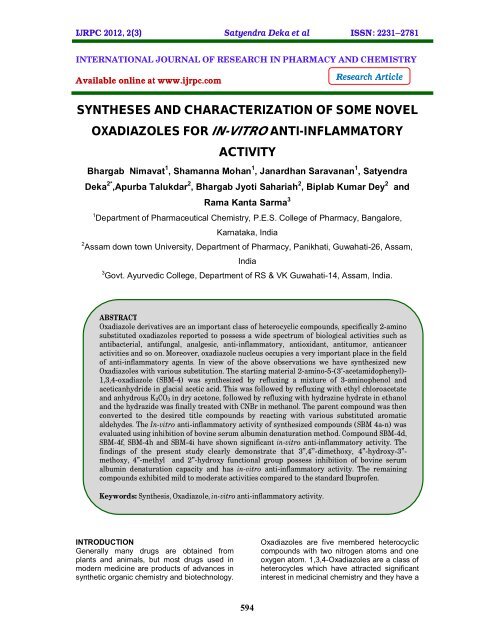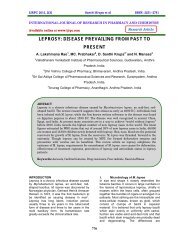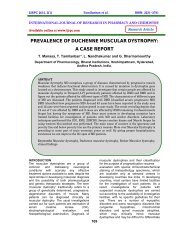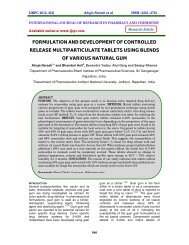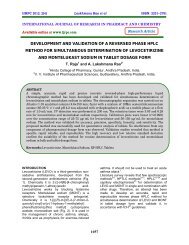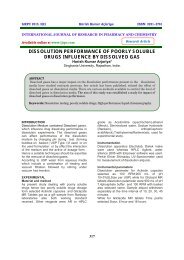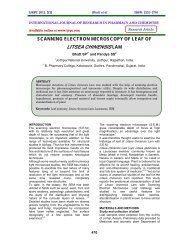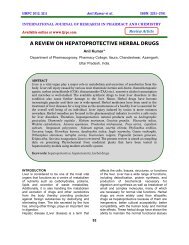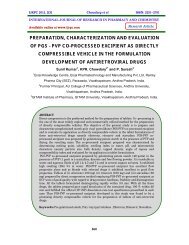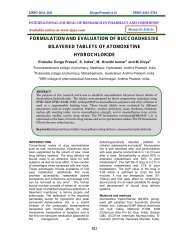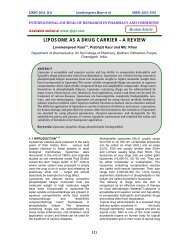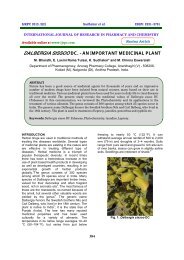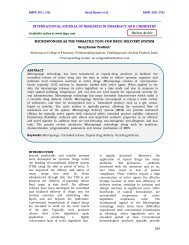syntheses and characterization of some novel oxadiazoles for ... - ijrpc
syntheses and characterization of some novel oxadiazoles for ... - ijrpc
syntheses and characterization of some novel oxadiazoles for ... - ijrpc
Create successful ePaper yourself
Turn your PDF publications into a flip-book with our unique Google optimized e-Paper software.
IJRPC 2012, 2(3) Satyendra Deka et al ISSN: 22312781<br />
INTERNATIONAL JOURNAL OF RESEARCH IN PHARMACY AND CHEMISTRY<br />
Available online at www.<strong>ijrpc</strong>.com<br />
Research Article<br />
SYNTHESES AND CHARACTERIZATION OF SOME NOVEL<br />
OXADIAZOLES FOR IN-VITRO ANTI-INFLAMMATORY<br />
ACTIVITY<br />
Bhargab Nimavat 1 , Shamanna Mohan 1 , Janardhan Saravanan 1 , Satyendra<br />
Deka 2* ,Apurba Talukdar 2 , Bhargab Jyoti Sahariah 2 , Biplab Kumar Dey 2 <strong>and</strong><br />
Rama Kanta Sarma 3<br />
1 Department <strong>of</strong> Pharmaceutical Chemistry, P.E.S. College <strong>of</strong> Pharmacy, Bangalore,<br />
Karnataka, India<br />
2 Assam down town University, Department <strong>of</strong> Pharmacy, Panikhati, Guwahati-26, Assam,<br />
India<br />
3 Govt. Ayurvedic College, Department <strong>of</strong> RS & VK Guwahati-14, Assam, India.<br />
ABSTRACT<br />
Oxadiazole derivatives are an important class <strong>of</strong> heterocyclic compounds, specifically 2-amino<br />
substituted <strong>oxadiazoles</strong> reported to possess a wide spectrum <strong>of</strong> biological activities such as<br />
antibacterial, antifungal, analgesic, anti-inflammatory, antioxidant, antitumor, anticancer<br />
activities <strong>and</strong> so on. Moreover, oxadiazole nucleus occupies a very important place in the field<br />
<strong>of</strong> anti-inflammatory agents. In view <strong>of</strong> the above observations we have synthesized new<br />
Oxadiazoles with various substitution. The starting material 2-amino-5-(3’-acetamidophenyl)-<br />
1,3,4-oxadiazole (SBM-4) was synthesized by refluxing a mixture <strong>of</strong> 3-aminophenol <strong>and</strong><br />
aceticanhydride in glacial acetic acid. This was followed by refluxing with ethyl chloroacetate<br />
<strong>and</strong> anhydrous K 2CO 3 in dry acetone, followed by refluxing with hydrazine hydrate in ethanol<br />
<strong>and</strong> the hydrazide was finally treated with CNBr in methanol. The parent compound was then<br />
converted to the desired title compounds by reacting with various substituted aromatic<br />
aldehydes. The In-vitro anti-inflammatory activity <strong>of</strong> synthesized compounds (SBM 4a-n) was<br />
evaluated using inhibition <strong>of</strong> bovine serum albumin denaturation method. Compound SBM-4d,<br />
SBM-4f, SBM-4h <strong>and</strong> SBM-4i have shown significant in-vitro anti-inflammatory activity. The<br />
findings <strong>of</strong> the present study clearly demonstrate that 3”,4’’-dimethoxy, 4”-hydroxy-3”-<br />
methoxy, 4”-methyl <strong>and</strong> 2”-hydroxy functional group possess inhibition <strong>of</strong> bovine serum<br />
albumin denaturation capacity <strong>and</strong> has in-vitro anti-inflammatory activity. The remaining<br />
compounds exhibited mild to moderate activities compared to the st<strong>and</strong>ard Ibupr<strong>of</strong>en.<br />
Keywords: Synthesis, Oxadiazole, in-vitro anti-inflammatory activity.<br />
INTRODUCTION<br />
Generally many drugs are obtained from<br />
plants <strong>and</strong> animals, but most drugs used in<br />
modern medicine are products <strong>of</strong> advances in<br />
synthetic organic chemistry <strong>and</strong> biotechnology.<br />
Oxadiazoles are five membered heterocyclic<br />
compounds with two nitrogen atoms <strong>and</strong> one<br />
oxygen atom. 1,3,4-Oxadiazoles are a class <strong>of</strong><br />
heterocycles which have attracted significant<br />
interest in medicinal chemistry <strong>and</strong> they have a<br />
594
IJRPC 2012, 2(3) Satyendra Deka et al ISSN: 22312781<br />
wide range <strong>of</strong> pharmaceutical <strong>and</strong> biological<br />
activities. Molecules containing a 1,3,4-<br />
oxadiazole core have been shown to have a<br />
broad range <strong>of</strong> important biological activities<br />
including antimicrobial (1-3), pesticidal, antimycobacterial,<br />
antitumor (4-5) , antiinflammatory<br />
(6-8), anti-convulsant,<br />
insecticidal, anti-cancer, <strong>and</strong> anti-hypertensive<br />
properties. Among the 1,3,4-<strong>oxadiazoles</strong>, 2,5-<br />
unsymmetrical disubstituted derivatives have<br />
attracted considerable attention because <strong>of</strong><br />
their biological <strong>and</strong> electrochemical properties.<br />
Numerous studies have been per<strong>for</strong>med with<br />
the aim <strong>of</strong> exploring the anti-inflammatory<br />
properties <strong>of</strong> 1,3,4-oxadiazole analogues.<br />
These studies found that 1,3,4-oxadiazole<br />
analogues are equipotent with<br />
phenylbutazone, naproxen <strong>and</strong> other NSAIDs.<br />
Oxatamine can be used as an antiinflammatory<br />
agent in case <strong>of</strong> respiratory tract<br />
infection, it contains the oxadiazole<br />
heterocycle. Methazole <strong>and</strong> Pleconaril also<br />
contain oxadiazole heterocycle that are having<br />
herbicide <strong>and</strong> anti-viral activity respectively.<br />
With the aim <strong>of</strong> finding a COX/LOs dual<br />
inhibitor, which may have improved efficacy<br />
<strong>and</strong> fewer side effects compared with existing<br />
NSAIDs, we considered it <strong>of</strong> interest to<br />
synthesize <strong>novel</strong> 1,3,4-oxadiazole analogues<br />
to investigate their anti-inflammatory activity.<br />
MATERIALS AND METHODS<br />
Step-1<br />
Synthesis <strong>of</strong> 3-Acetamido phenol (SBM-1)<br />
A mixture <strong>of</strong> 3-Amino phenol (21.8 g, 0.2<br />
mole), acetic anhydride (24ml, 0.3 mole) <strong>and</strong><br />
glacial acetic acid (60ml) were refluxed <strong>for</strong> 4<br />
hrs. Excess solvent was removed by<br />
distillation <strong>and</strong> the residual mixture was poured<br />
over crushed ice. The resultant product was<br />
recrystallized from water to yield pure 3-<br />
Acetamido phenol (SBM-1). % Yield: 71%,<br />
M.P.: 152 0 C, IR (KBr) (cm -1 ): 3594.21(O-H),<br />
3461.47 (NH stretch <strong>of</strong> amide), 3098.06 (Ar. C-<br />
H), 2961.17 (Ali. C-H), 1684.73 (C=O <strong>of</strong><br />
amide), 1578.96 (NH bend), 1605.49 &<br />
1468.42 (Ar. C=C), 898.92 (Ar. C-H bend).<br />
Step-2<br />
Synthesis <strong>of</strong> Ethyl-(3-acetamidophenoxy)-<br />
acetate (SBM-2)<br />
A mixture <strong>of</strong> 3-Acetamido phenol (15.1 gm, 0.1<br />
mole), Ethylchloroacetate (10.5 ml, 0.1mole)<br />
<strong>and</strong> anhydrous K 2 CO 3 (20.7 gm, 0.15 mole) in<br />
dry acetone (150 ml) was refluxed on a water<br />
bath <strong>for</strong> 24 hrs. The reaction mixture was<br />
cooled <strong>and</strong> filtered <strong>and</strong> from filtrate excess<br />
acetone was removed by distillation. Then the<br />
reaction mixture was poured into ice cold<br />
water <strong>and</strong> stirred well. The resultant product<br />
was recrystallized with ethanol (95%) to yield<br />
pure Ethyl-(3-acetamidophenoxy)-acetate<br />
(SBM-2). % Yield: 62%, M.P.: 70 0 C, IR (KBr)<br />
(cm -1 ): 1752.87 (C=O <strong>of</strong> ester), 3460.76 (NH<br />
stretch <strong>of</strong> amide), 3109.83 (Ar. C-H), 2990.38<br />
(Ali. C-H), 1684.85 (C=O <strong>of</strong> amide), 1560.24<br />
(NH bend), 1218.35 (Ar-O-C), 1170.71 (O-<br />
C 2 H 5 ), 1600.76 & 1469.74 (Ar. C=C), 830.86<br />
(Ar. C-H bend)<br />
Step-3<br />
Synthesis <strong>of</strong> 2-(3’-Acetamidophenoxy)-<br />
acetohydrazide (SBM-3)<br />
A mixture <strong>of</strong> Ethyl-(3-acetamidophenoxy)-<br />
acetate (11.85 gm, 0.05 mole) <strong>and</strong> hydrazine<br />
hydrate 99% (10 ml, 0.2 mole) in ethanol (50<br />
ml) was refluxed <strong>for</strong> 8 hrs. Excess <strong>of</strong> ethanol<br />
was removed by distillation. On cooling 2-(3’-<br />
acetamidophenoxy)-acetohydrazide initiated to<br />
separate. It was collected by filtration <strong>and</strong><br />
recrystallized with ethanol (95%) to yield pure<br />
2-(3’-Acetamidophenoxy)-acetohydrazide<br />
(SBM-3). % Yield: 80%, M.P.: 175 0 C, IR (KBr)<br />
(cm -1 ) : 3344.84(NH 2 strech), 3470.46 (NH<br />
stretch <strong>of</strong> amide), 3078.79 (Ar. C-H), 2919.37<br />
(Ali. C-H), 1680.65 (C=O <strong>of</strong> amide), 1556.75<br />
(NH 2 bend), 1520.40 (NH bend), 1230.14 (Ar-<br />
O-C), 1605.17 & 1463.92 (Ar. C=C), 840.51<br />
(Ar. C-H bend).<br />
Step-4<br />
Synthesis <strong>of</strong> 2-Amino-5- (3’-<br />
acetamidophenoxymethyl)-1,3,4-oxadiazole<br />
(SBM-4)<br />
2-(3’-Acetamidophenoxy)-acetohydrazide<br />
(4.46 gm, 0.02 mole) was added to a solution<br />
<strong>of</strong> Cyanogen bromide (2.12 gm, 0.02 mole) in<br />
50 ml <strong>of</strong> methanol in such a way that the temp.<br />
should not rise above 40 0 C. The solution was<br />
then stirred <strong>for</strong> 1.5 hrs at 40 0 C <strong>and</strong> then it was<br />
refluxed at 70 0 C <strong>for</strong> 1.5 hrs, filtered hot <strong>and</strong><br />
allowed to cool at room temp. Then the<br />
solution was neutralized with dil. ammonia.<br />
The resultant product was collected <strong>and</strong><br />
recrystallized with methanol to yield pure 2-<br />
Amino-5-(3’-acetamidophenoxymethyl)-1,3,4-<br />
oxadiazole (SBM-4). % Yield: 54% , M.P.:<br />
198 0 C, IR (KBr) (cm -1 ) : 3394.45 (NH 2 strech),<br />
3473.17 (NH stretch <strong>of</strong> amide), 3116.70 (Ar. C-<br />
H), 2901.86 (Ali. C-H), 1674.46 (C=O <strong>of</strong><br />
amide), 1090.48 (C-O <strong>of</strong> Oxadiazole), 1640.71<br />
(C=N), 1561.23 (NH bend), 1230.6 (Ar-O-C),<br />
1460.24 (Ar. C=C), 830.8 (Ar. C-H bend)<br />
595
IJRPC 2012, 2(3) Satyendra Deka et al ISSN: 22312781<br />
SCHEME<br />
Step-1<br />
OH<br />
OH<br />
(CH 3 CO) 2 O<br />
Acetylation<br />
Refluxed <strong>for</strong> 4 hrs<br />
Step-2<br />
NH 2<br />
3-Amino phenol Acetic anhydride<br />
OH<br />
O<br />
Dry Acetone<br />
ClCH 2 COOC 2 H 5<br />
Anhydrous K 2 CO 3<br />
NHCOCH 3<br />
Refluxed <strong>for</strong> 24 hrs<br />
NHCOCH 3<br />
3-Acetamido Phenol<br />
(SBM-1)<br />
CH 2 COOC 2 H 5<br />
NHCOCH 3<br />
Step-3<br />
3-Acetamido phenol<br />
(SBM-1)<br />
O<br />
CH 2 COOC 2 H 5<br />
Ethylchloroacetate<br />
Ethyl-(3-acetamidophenoxy)-<br />
acetate<br />
(SBM-2)<br />
O<br />
CH 2 CO NHNH 2<br />
NH 2 NH 2 .H 2 O<br />
Ethanol<br />
Refluxed <strong>for</strong> 8 hrs<br />
NHCOCH 3<br />
Ethyl-(3-acetamidophenoxy)-<br />
acetate<br />
(SBM-2)<br />
Hydrazine hydrate<br />
NHCOCH 3<br />
2-(3'-Acetamidophenoxy)-<br />
acetohydrazide<br />
(SBM-3)<br />
Step-4<br />
N<br />
N<br />
O<br />
CH 2 CO NHNH 2<br />
O<br />
CH 2<br />
O<br />
NH 2<br />
CNBr<br />
Methanol<br />
NHCOCH 3<br />
NHCOCH 3<br />
Step-5<br />
2-(3'-Acetamidophenoxy)-<br />
acetohydrazide<br />
(SBM-3)<br />
Cyanogen<br />
bromide<br />
2-Amino-5-(3'-acetamidophenoxy<br />
methyl)-1,3,4-oxadiazole<br />
(SBM-4)<br />
N<br />
N<br />
N<br />
N<br />
O<br />
CH2<br />
O<br />
NH 2<br />
CHO<br />
O<br />
CH 2<br />
O<br />
N<br />
CH<br />
NHCOCH 3<br />
2-Amino-5-(3'-acetamidophenoxy<br />
methyl)-1,3,4-oxadiazole<br />
(SBM-4)<br />
R<br />
Various aromatic<br />
aldehydes (a-n)<br />
Isopropanol<br />
G.A.A.<br />
Refluxed <strong>for</strong> 6 hrs<br />
NHCOCH 3<br />
2-[(substituted benzylidene) imino]-5-(3'-acetamidophenoxy methyl)<br />
-1,3,4-<strong>oxadiazoles</strong> (Schiff bases) SBM-4(a-n)<br />
R<br />
596
IJRPC 2012, 2(3) Satyendra Deka et al ISSN: 22312781<br />
R Sample code R Sample code<br />
4-chloro SBM - 4a 4-methyl SBM – 4h<br />
4-dimethylamino SBM – 4b 2-hydroxy SBM – 4i<br />
2-nitro SBM – 4c 4-methoxy SBM – 4j<br />
3, 4-dimethoxy SBM – 4d 3-nitro SBM – 4k<br />
4-hydroxy SBM – 4e 3,4,5-trimethoxy SBM – 4l<br />
4-hydroxy-3-methoxy SBM – 4f H SBM – 4m<br />
2-chloro SBM – 4g 4-nitro SBM – 4n<br />
Step-5<br />
General method <strong>for</strong> the <strong>syntheses</strong> <strong>of</strong> 2-<br />
[(substituted benzylidene) imino]-5-(3’-<br />
acetamidophenoxy<br />
methyl)-1,3,4-<br />
<strong>oxadiazoles</strong> (SBM 4a-n) (Schiff bases)<br />
A mixture <strong>of</strong> 2-Amino-5-(3’-acetamidophenoxy<br />
methyl)-1,3,4-oxadiazole (SBM-4) (0.001 mol),<br />
the required aryl aldehydes (0.001 mol) in<br />
isopropanol (15 ml) <strong>and</strong> catalytic amount <strong>of</strong><br />
glacial acetic acid (0.5 ml) was subjected to<br />
reflux <strong>for</strong> 6 hrs. The reaction mixture was<br />
cooled to room temperature. The solid<br />
separated was filtered, washed with<br />
isopropanol <strong>and</strong> recrystallized with DMF :<br />
Water mixture (5:2). The new titled compounds<br />
<strong>for</strong>med were confirmed by MP, TLC, IR <strong>and</strong><br />
representative compounds by NMR <strong>and</strong> Mass<br />
spectra.<br />
In-vitro Anti-inflammatory activity<br />
The synthesized compounds were screened<br />
<strong>for</strong> in-vitro anti-inflammatory activity by<br />
inhibition <strong>of</strong> bovine serum albumin<br />
denaturation method according to M.N.A. Rao<br />
et al (9).<br />
Experimental design<br />
The test compounds were dissolved in<br />
minimum amount <strong>of</strong> dimethyl <strong>for</strong>mamide<br />
(DMF) <strong>and</strong> diluted with phosphate buffer<br />
(0.2M, pH 7.4). Final concentration <strong>of</strong> DMF in<br />
all solution was less than 2.5%. Test solution<br />
(1 ml) containing different concentrations <strong>of</strong><br />
drug was mixed with 1 ml <strong>of</strong> 1mM albumin<br />
solution in phosphate buffer <strong>and</strong> incubated at<br />
27 0 ±1 0 C <strong>for</strong> 15 min. Denaturation was<br />
induced by keeping the reaction mixture at<br />
60 0 ± 1 0 C in a water bath <strong>for</strong> 10 min. After<br />
cooling the turbidity was measured at 660 nm.<br />
(Shimadzu Spectrometer). Percentage<br />
inhibition <strong>of</strong> denaturation was calculated from<br />
control where no drug was added. Each<br />
experiment was done in triplicate <strong>and</strong> the<br />
average was taken. The percentage <strong>of</strong><br />
inhibition is calculated from the following<br />
<strong>for</strong>mula.<br />
The st<strong>and</strong>ard solution was also prepared as<br />
similar to that <strong>of</strong> the test solution. Ibupr<strong>of</strong>en<br />
was used as a st<strong>and</strong>ard.<br />
% Inhibition = 100(1 - Vt/Vc)<br />
Where,<br />
Vt = Drug absorbance <strong>of</strong> triplicate average<br />
Vc = Control absorbance <strong>of</strong> triplicate average<br />
RESULTS<br />
Physical data<br />
Melting points were determined in open<br />
capillaries <strong>and</strong> are uncorrected. Purity <strong>of</strong> the<br />
compounds was checked by TLC on silica gel<br />
plates. The solvent system used to carry out<br />
the TLC is Toluene : Acetonitrile (2:8). The<br />
physical data are reported in Table 1.<br />
Spectral data<br />
IR spectra (cm -2 ) were recorded in KBr on a<br />
Shimadzu FTIR-8700 spectrometer. 1 H NMR<br />
(ppm) in DMSO using TMS as reference on<br />
Bruker 400 AMX. Mass spectra <strong>of</strong> the<br />
compound coded SBM-4 was carried out.<br />
IR (KBr) cm -2<br />
Compound SBM -4a<br />
3462.89 (NH stretch <strong>of</strong> amide), 3156.49 (Ar. C-<br />
H), 2986.47 (Ali. C-H), 1676.81 (C=O <strong>of</strong><br />
amide), 1097.60 (C-O <strong>of</strong> Oxadiazole), 771.70<br />
(C-Cl), 1648.53 (C=N), 1598.65 (N=CH),<br />
1561.35 (NH bend), 1224.18 (Ar-O-C),<br />
1489.91 (Ar. C=C), 920.08 (Ar. C-H bend).<br />
Compound SBM-4b<br />
3465.42 (NH stretch <strong>of</strong> amide), 3045.05 (Ar. C-<br />
H), 2924.27 (Ali. C-H), 1684.57 (C=O <strong>of</strong><br />
amide), 1098.83 (C-O <strong>of</strong> Oxadiazole), 1656.41<br />
(C=N), 1583.52 (N=CH), 1530.63 (NH bend),<br />
1228.45 (Ar-O-C), 1412.44 (Ar. C=C), 831.21<br />
(Ar. C-H bend).<br />
Compound SBM-4c<br />
1550.93 & 1378.21 (N=O), 3470.46 (NH<br />
stretch <strong>of</strong> amide), 3155.76<br />
(Ar. C-H), 2980.67 (Ali. C-H), 1685.17 (C=O <strong>of</strong><br />
amide), 1093.82 (C-O <strong>of</strong> Oxadiazole), 1640.05<br />
(C=N), 1605.81 (N=CH), 1596.06 (NH bend),<br />
1245.46 (Ar-O-C), 1417.65 (Ar. C=C), 837.31<br />
(Ar. C-H bend).<br />
Compound SBM-4d<br />
3465.57 (NH stretch <strong>of</strong> amide), 3158.65 (Ar. C-<br />
H), 2980.43 (Ali. C-H), 1684.01 (C=O <strong>of</strong><br />
amide), 1098.47 (C-O <strong>of</strong> Oxadiazole), 1650.21<br />
(C=N), 1596.84 (N=CH), 1550.90 (NH bend),<br />
597
IJRPC 2012, 2(3) Satyendra Deka et al ISSN: 22312781<br />
1223.93 (Ar-O-C), 1247.59 (C-O-CH 3 ),<br />
1456.23 (Ar. C=C), 835.73 (Ar. C-H bend).<br />
Compound SBM-4e<br />
3580.36 (O-H), 3463.58 (NH stretch <strong>of</strong> amide),<br />
3151.47 (Ar. C-H), 2975.71 (Ali. C-H), 1694.05<br />
(C=O <strong>of</strong> amide), 1089.26 (C-O <strong>of</strong> Oxadiazole),<br />
1630.35 (C=N), 1590.92 (N=CH), 1546.92 (NH<br />
bend), 1220.53 (Ar-O-C), 1450.74 (Ar. C=C),<br />
828.04 (Ar. C-H bend).<br />
Compound SBM-4f<br />
3510.99(O-H), 3466.14 (NH stretch <strong>of</strong> amide),<br />
3197.67 (Ar. C-H), 3074.19 (Ali. C-H), 1688.28<br />
(C=O <strong>of</strong> amide), 1093.15 (C-O <strong>of</strong> Oxadiazole),<br />
1648.23 (C=N), 1579.89 (N=CH), 1550.75 (NH<br />
bend), 1226.83 (Ar-O-C), 1259.54 (C-O-CH 3 ),<br />
1483.78 (Ar. C=C), 901.45 (Ar. C-H bend).<br />
Compound SBM-4g<br />
3465.83 (NH stretch <strong>of</strong> amide), 3120.37 (Ar. C-<br />
H), 2980.41 (Ali. C-H), 1658.79 (C=O <strong>of</strong><br />
amide), 1090.67 (C-O <strong>of</strong> Oxadiazole), 760.59<br />
(C-Cl), 1620.54 (C=N), 1574.43 (N=CH),<br />
1563.07 (NH bend), 1228.74 (Ar-O-C),<br />
1484.91 (Ar. C=C), 901.73 (Ar. C-H bend)<br />
Compound SBM-4h<br />
3460.65 (NH stretch <strong>of</strong> amide), 3116.53 (Ar. C-<br />
H), 2912.30 (Ali. C-H), 1679.15 (C=O <strong>of</strong><br />
amide), 1091.75 (C-O <strong>of</strong> Oxadiazole), 1621.71<br />
(C=N), 1602.50 (N=CH), 1568.07 (NH bend),<br />
1224.18 (Ar-O-C), 1489.97 (Ar. C=C), 824.76<br />
(Ar. C-H bend).<br />
Compound SBM-4i<br />
3598.46 (O-H), 3455.12 (NH stretch <strong>of</strong> amide),<br />
3150.73 (Ar. C-H), 2998.06 (Ali. C-H), 1684.22<br />
(C=O <strong>of</strong> amide), 1095.82 (C-O <strong>of</strong> Oxadiazole),<br />
1622.60 (C=N), 1592.31 (N=CH), 1559.30 (NH<br />
bend), 1223.96 (Ar-O-C), 1447.29 (Ar. C=C),<br />
826.04 (Ar. C-H bend).<br />
Compound SBM-4j<br />
3467.55 (NH stretch <strong>of</strong> amide), 3060.75 (Ar. C-<br />
H), 2975.83 (Ali. C-H), 1687.92 (C=O <strong>of</strong><br />
amide), 1084.96 (C-O <strong>of</strong> Oxadiazole), 1652.85<br />
(C=N), 1570.36 (N=CH), 1553.90 (NH bend),<br />
1211.43 (Ar-O-C), 1240.52 (C-O-CH 3 ),<br />
1430.82 (Ar. C=C), 830.73 (Ar. C-H bend).<br />
Compound SBM-4k<br />
1546.63 & 1363.14 (N=O), 3460.41 (NH<br />
stretch <strong>of</strong> amide), 3106.73 (Ar. C-H), 2981.38<br />
(Ali. C-H), 1681.78 (C=O <strong>of</strong> amide), 1090.31<br />
(C-O <strong>of</strong> Oxadiazole), 1650.19 (C=N), 1603.58<br />
(N=CH), 1568.49 (NH bend), 1223.07 (Ar-O-<br />
C), 1430.46 (Ar. C=C), 823.63 (Ar. C-H bend).<br />
Compound SBM-4l<br />
3450.71 (NH stretch <strong>of</strong> amide), 3126.15 (Ar. C-<br />
H), 2976.89 (Ali. C-H), 1681.40 (C=O <strong>of</strong><br />
amide), 1089.18 (C-O <strong>of</strong> Oxadiazole),<br />
1654.34 (C=N), 1583.73 (N=CH), 1569.35 (NH<br />
bend), 1234.88 (Ar-O-C), 1251.54 (C-O-CH 3 ),<br />
1454.16 (Ar. C=C), 831.36 (Ar. C-H bend).<br />
Compound SBM-4m<br />
3457.63 (NH stretch <strong>of</strong> amide), 3161.48 (Ar. C-<br />
H), 2996.84 (Ali. C-H), 1667.72 (C=O <strong>of</strong><br />
amide), 1087.53 (C-O <strong>of</strong> Oxadiazole), 1628.57<br />
(C=N), 1591.67 (N=CH), 1560.34 (NH bend),<br />
1218.14 (Ar-O-C), 1441.50 (Ar. C=C), 828.04<br />
(Ar. C-H bend).<br />
Compound SBM-4n<br />
1501.35 & 1354.73 (N=O), 3463.90 (NH<br />
stretch <strong>of</strong> amide), 3110.67 (Ar. C-H), 2991.83<br />
(Ali. C-H), 1674.46 (C=O <strong>of</strong> amide), 1091.18<br />
(C-O <strong>of</strong> Oxadiazole), 1650.48 (C=N), 1598.96<br />
(N=CH), 1561.23 (NH bend), 1230.60 (Ar-O-<br />
C), 1426.48 (Ar. C=C), 829.38 (Ar. C-H bend).<br />
1 H NMR (DMSO) δ (ppm)<br />
Compound SBM-4<br />
2.01 (s, 3H, CH 3 at e); 5.08 (s, 2H, O-CH 2, at<br />
f); 6.73 (s, 2H, NH 2 at g); 7.14 (d, 2H, CH, ArH,<br />
at a, a’); 7.20 (t, 1H, CH, ArH, at b); 7.31 (d,<br />
1H, CH ArH at c); 9.92 (s, 1H, NH at d).<br />
Compound SBM -4a<br />
2.07 (s,3H, CH 3 at e) ; 5.36 (s,2H, O-CH 2 at f);<br />
7.14 (d, 2H, CH, ArH at a ,a’); 7.18 (d, 4H, CH,<br />
ArH at h, h’, i , i’); 7.251 (t, 1H, CH, ArH at b);<br />
7.32 (d, 1H, CH, ArH at c); 9.91 (s, 1H, NH at<br />
d) ; 10.16 (s,1H, N=CH at g).<br />
Compound SBM-4h<br />
2.08 (s,3H, CH 3 at e) ; 3.38 (s,3H, Ar-CH 3 at j);<br />
5.08 (s,2H, O-CH 2 at f); 6.92 (d, 2H, CH, ArH<br />
at a ,a’); 7.18 (d, 4H, CH, ArH at h, h’, i , i’);<br />
7.31 (t, 1H, CH, ArH at b); 7.41 (d, 1H, CH,<br />
ArH at c); 9.50 (s, 1H, NH at d) ; 10.09 (s,1H,<br />
N=CH at g).<br />
In-vitro Anti-inflammatory activity data<br />
Anti-inflammatory activity (10) was carried out<br />
using Bovine Serum albumin denaturation<br />
method. All the title compounds (SBM-4a-n)<br />
were screened <strong>for</strong> anti-inflammatory activity.<br />
The results <strong>of</strong> the anti-inflammatory activity <strong>of</strong><br />
the compounds are shown in the table <strong>and</strong><br />
graphs. SBM-4d, SBM-4f, SBM-4h <strong>and</strong> SBM-4i<br />
having substituents 3”,4’’-dimethoxy, 4”-<br />
hydroxy-3”-methoxy, 4”-methyl <strong>and</strong> 2”-hydroxy<br />
; respectively showed good activity. Whereas<br />
compounds SBM-4a, SBM-4b <strong>and</strong> SBM-4l<br />
having 4”-chloro, 4”-dimethylamino, 3”,4”,5”-<br />
trimethoxy respectively showed mild activity<br />
598
IJRPC 2012, 2(3) Satyendra Deka et al ISSN: 22312781<br />
<strong>and</strong> remaining compounds showed poor antiinflammatory<br />
activity.<br />
DISCUSSION<br />
The purpose <strong>of</strong> the present work was to<br />
synthesize a series <strong>of</strong> desired title compounds<br />
from 2-amino-5-(3’-acetamido phenoxy<br />
methyl)-1,3,4-oxadiazole (SBM-4) by reacting<br />
with various substituted aromatic aldehydes.<br />
The <strong>syntheses</strong> were carried out in accordance<br />
with the literature as in the scheme.<br />
As discussed earlier, <strong>oxadiazoles</strong> are a class<br />
<strong>of</strong> heterocyclic compounds that shows an<br />
array <strong>of</strong> biological activities which include antiinflammatory,<br />
anti-oxidant, anti-fungal, antibacterial,<br />
anti-tubercular, anti-convulsant, anticancer,<br />
anti-HIV, anti-convulsant, anti-diabetic<br />
<strong>and</strong> so on.<br />
Thus, it was felt worthwhile to take up the<br />
present investigation to synthesize a <strong>novel</strong><br />
class <strong>of</strong> <strong>oxadiazoles</strong> using four steps <strong>and</strong> test<br />
their effect on anti-inflammatory activity.<br />
Clinically established anti-inflammatory drugs<br />
have shown to inhibit heat coagulation <strong>of</strong><br />
proteins. These anti-inflammatory drugs have<br />
exerted an inhibitory activity on immune<br />
haemolysis <strong>and</strong> also have suppressive effect<br />
on vascular reactivity. Denaturation as one <strong>of</strong><br />
the causes <strong>of</strong> inflammation is well<br />
documented. Anti-inflammatory drugs interact<br />
in <strong>some</strong> way with proteins. To cause the<br />
interaction between the drug <strong>and</strong> the proteins,<br />
the stability <strong>of</strong> proteins against heat<br />
coagulation can be measured.<br />
The in-vitro anti-inflammatory activity; was<br />
carried out using inhibition <strong>of</strong> bovine serum<br />
albumin denaturation method according to<br />
M.N.A. Rao et al. All the compounds (SBM-4an)<br />
were screened <strong>for</strong> in-vitro anti-inflammatory<br />
activity. The results are shown in the Table 2<br />
<strong>and</strong> Figure 1.<br />
CONCLUSION<br />
In conclusion, from the in-vitro antiinflammatory<br />
activity results, it was observed<br />
that both electron donating <strong>and</strong> electron<br />
withdrawing groups on the aldehydic phenyl<br />
ring <strong>of</strong> the compounds influenced the activity.<br />
Among all the compounds tested, SBM-4d with<br />
3”,4’’-dimethoxy, SBM-4f with 4”-hydroxy-3”-<br />
methoxy, SBM-4h with 4”-methyl <strong>and</strong> SBM-4i<br />
with 2”-hydroxy substitution at R showed good<br />
in-vitro anti-inflammatory activity. The<br />
remaining compounds exhibited mild to<br />
moderate activities compared to the st<strong>and</strong>ard<br />
Ibupr<strong>of</strong>en.<br />
ACKNOWLEDGEMENT<br />
The authors wish to thank Dr. S Mohan.<br />
Principal, PES College <strong>of</strong> Pharmacy, Dr. J<br />
Saravanan HOD, Pharmaceutical Chemistry<br />
Department <strong>and</strong> the Management <strong>of</strong> PES<br />
College <strong>of</strong> Pharmacy <strong>for</strong> providing facilities to<br />
carry out the research work.<br />
Table 1: Physical data <strong>of</strong> compounds prepared<br />
Comp Molecular <strong>for</strong>mula M.W. (gm) M.P. ( o C) R f Value Yield (%)<br />
SBM -1 C 8H 9NO 2 151 152 0.61 71<br />
SBM -2 C 12H 15NO 4 237 70 0.71 62<br />
SBM -3 C 10H 13N 3O 3 223 175 0.37 80<br />
SBM -4 C 11H 12N 4O 3 248 198 0.67 54<br />
SBM -4a C 18H 15ClN 4O 3 370 171 0.61 60<br />
SBM -4b C 20H 21N 5O 3 379 190 0.78 62.1<br />
SBM -4c C 18H 15N 5O 5 381 192 0.82 58.6<br />
SBM -4d C 20H 20N 4O 5 396 194 0.73 59.4<br />
SBM -4e C 18H 16N 4O 4 352 188 0.77 53.6<br />
SBM -4f C 19H 18N 4O 5 382 191 0.69 51.9<br />
SBM -4g C 18H 15ClN 4O 3 370 176 0.62 56.7<br />
SBM -4h C 19H 18N 4O 3 350 186 0.71 64.3<br />
SBM -4i C 18H 16N 4O 4 352 193 0.76 57.1<br />
SBM -4j C 19H 18N 4O 4 366 175 0.80 57.6<br />
SBM -4k C 18H 15N 5O 5 381 185 0.72 55.4<br />
SBM -4l C 21H 22N 4O 6 426 180 0.64 52.3<br />
SBM -4m C 18H 16N 4O 3 336 183 0.78 55.6<br />
SBM -4n C 18H 15N 5O 5 381 181 0.84 58.3<br />
599
IJRPC 2012, 2(3) Satyendra Deka et al ISSN: 22312781<br />
Table 2: In-vitro Anti-inflammatory activity data<br />
Comp Code<br />
% Inhibition IC 50<br />
10µgm 20µgm 30µgm Avg µgm/ml<br />
SBM-4a 46.15 69.23 80.77 65.38 15.30<br />
SBM-4b 44.23 67.31 78.85 63.46 15.75<br />
SBM-4c 34.62 63.46 75 57.70 17.33<br />
SBM-4d 59.61 73.08 80.77 71.15 14.05<br />
SBM-4e 51.92 71.15 82.69 68.59 14.58<br />
SBM-4f 53.85 65.38 84.62 67.95 14.71<br />
SBM-4g 48.08 63.46 82.69 64.74 15.44<br />
SBM-4h 57.69 71.15 80.77 69.87 14.31<br />
SBM-4i 50.00 67.31 82.69 66.67 14.99<br />
SBM-4j 38.46 59.62 73.08 57.05 17.53<br />
SBM-4k 40.38 59.62 78.85 59.62 16.77<br />
SBM-4l 44.23 65.38 78.85 62.82 15.92<br />
SBM-4m 25.00 57.69 69.23 50.64 19.75<br />
SBM-4n 38.46 63.46 73.08 58.34 17.14<br />
Ibupr<strong>of</strong>en 73.08 82.69 92.31 82.69 12.09<br />
600
IJRPC 2012, 2(3) Satyendra Deka et al ISSN: 22312781<br />
Fig. 1: Graphical representation <strong>of</strong> in-vitro<br />
Anti-inflammatory activity data<br />
REFERENCES<br />
1. Kanthiah S, Kalusalingam A,<br />
Velayutham R, Vimala AT <strong>and</strong><br />
Beyatricks J. 5-(2-aminophenyl)-1,3,4-<br />
oxadiazole-2(3H)-thione derivatives :<br />
Synthesis, <strong>characterization</strong> <strong>and</strong><br />
antimicrobial evaluation. International<br />
Journal <strong>of</strong> Pharmaceutical Sciences<br />
Review <strong>and</strong> Research. 2011;6(1):64-7.<br />
2. Sridhara AM, Reddy KRV,<br />
Keshavayya J, Goud PSK,<br />
Somashekar BC <strong>and</strong> Bose P.<br />
Synthesis <strong>and</strong> antimicrobial activity <strong>of</strong><br />
2-substituted [4-(1,3,4-oxadiazol-2-yl<br />
methyl)] phthalazin-1(2H)-one<br />
derivatives. Eur J Med Chem.<br />
2010;45:4983-9.<br />
3. Naveena CS, Boja P <strong>and</strong> Kumari NS.<br />
Synthesis, <strong>characterization</strong> <strong>and</strong><br />
antimicrobial activity <strong>of</strong> <strong>some</strong><br />
disubstituted 1,3,4-<strong>oxadiazoles</strong><br />
carrying 2-(aryloxymethyl)phenyl<br />
moiety. Eur J Med Chem.<br />
2010;45:4708-19.<br />
4. Akhtar T, Hameed S, Al-Masoudi NA,<br />
Loddo R <strong>and</strong> Colla PL. In vitro<br />
antitumor <strong>and</strong> antiviral activities <strong>of</strong> new<br />
benzothiazole <strong>and</strong> 1,3,4-oxadiazole-2-<br />
thione derivatives. Acta Pharm.<br />
2008;58:135-49.<br />
5. Rostom SAF, Shalaby MA <strong>and</strong> El-<br />
Demellawy MA. Synthesis <strong>of</strong> new 1-(4-<br />
chlorophenyl)-4-hydroxy-1H-pyrazole-<br />
3-carboxylic acid hydrazide analogs<br />
<strong>and</strong> <strong>some</strong> derived ring systems. A<br />
<strong>novel</strong> class <strong>of</strong> potential antitumor <strong>and</strong><br />
anti-HCV agents. Eur J Med Chem.<br />
2003; 38:959-74.<br />
601
IJRPC 2012, 2(3) Satyendra Deka et al ISSN: 22312781<br />
6. Jayashankar B, Rai KML, Baskaran N<br />
<strong>and</strong> Sathish HS. Synthesis <strong>and</strong><br />
pharmacological evaluation <strong>of</strong> 1,3,4-<br />
oxadiazole bearing bis(heterocycle)<br />
derivatives as anti-inflammatory <strong>and</strong><br />
analgesic agents. Eur J Med Chem.<br />
2009; 44:3898–902.<br />
7. Akhter M, Husain A, Azad B <strong>and</strong> Ajmal<br />
M. Aroylpropionic acid based 2,5-<br />
disubstituted-1,3,4-<strong>oxadiazoles</strong>:<br />
Synthesis <strong>and</strong> their anti-inflammatory<br />
<strong>and</strong> analgesic activities. Eur J Med<br />
Chem. 2009; 44:2372–8.<br />
8. Bharathi D, Hemalatha S, Devadass<br />
G, Kumar PR, Shanmugasundaram P<br />
<strong>and</strong> Aan<strong>and</strong>hi MV. Synthesis,<br />
Characterisation <strong>and</strong> in-vitro Antiinflammatory<br />
<strong>and</strong> Anthelmintic<br />
activities <strong>of</strong> 1,3,4-Oxadiazole<br />
derivatives. International Journal <strong>of</strong><br />
Chem Tech Research. 2010;<br />
2(4):1867-70.<br />
9. Elias G <strong>and</strong> Rao MNA. Inhibition <strong>of</strong><br />
albumin Denaturation <strong>and</strong> antiinflammatory<br />
activity <strong>of</strong><br />
dehydrozingerone <strong>and</strong> its analogs. Ind<br />
J <strong>of</strong> Experimental biology. 1988; 26:<br />
540-42.<br />
10. Wagle S, Adhikari AV <strong>and</strong> Kumari NS.<br />
Synthesis <strong>of</strong> <strong>some</strong> new 2-(3-methyl-7-<br />
substituted-2-oxoquinoxalinyl)-5-(aryl)-<br />
1,3,4-<strong>oxadiazoles</strong> as potential nonsteroidal<br />
anti-inflammatory <strong>and</strong><br />
analgesic agents. Ind J Chem.<br />
2008;47B:439-48.<br />
602


